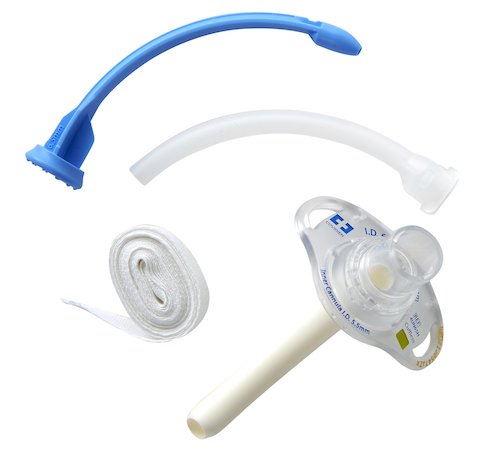Surgical Critical Care: Tracheostomy – Care & Weaning
Tracheostomy – Care/Weaning
Tube Exchange
- Inner Cannula:
- Change Every 8-12 Hours
- Done Routinely to Prevent Secretion Hardening & Obstruction
- Outer Cannula:
- First Postoperative Exchange After 7-10 Days
- Not Before 3-5 Days (Allow Tract Maturation)
- Exact Timing Not Well Defined
- Changing Every 1-2 Weeks Decreases Risk of Infection/Granulation Tissue
- First Postoperative Exchange After 7-10 Days
Allowing Airflow Around the Tube
- Methods:
- Down-Sizing (Decreasing Size of Tracheostomy Tube)
- Cuff Deflation
- Change to a Cuffless Tube
- Change to a Fenestrated Tube
- Benefits:
- Improves Comfort
- Facilitates Weaning on Spontaneous Breathing Trials with Shortened Weaning Time
- Allows More Airflow Past the Tube for Improved Speech Function
- Does Not Prevent Aspiration
Passy-Muir Valve (PMV/Speaking Valve)
- Valve Placed onto the Hub of the Tracheostomy
- One-Way Valve: Allows Air Inflow but Blocks on Expiration, Redirecting Airflow into Upper Airway
- Requires Either a Fenestrated Tracheostomy or Cuffless Tube (May Deflate Cuff Instead)
- “Finger Occlusion” While Speaking Can Serve the Same Function
Tracheostomy Weaning/Decannulation
- Indication: Once No Longer Requiring Airway Protection or Mechanical Ventilation
- Weaning Approach:
- Progressive Down-Sizing – Often Down to a Size 4 Shiley
- Wean to a Passy-Muir Valve
- Consider Capping/“Corking” the Tube
- NEVER:
- Cap a Non-Fenestrated Tube without Deflating the Cuff (No Source for Inspiration)
- Apply a PMV to a Non-Fenestrated Tube without Deflating the Cuff (No Route for Expiration)
- Decannulation Timing:
- Institution Dependent with Wide Variations
- Do Not Remove Before 7-10 Days (Tract Immature)
- Consider Decannulation Once Capped for ≥ 24-48 Hours
- Consider Once a Speaking Valve is Tolerated

Tracheostomy Obturator (Top), Inner Cannula (Middle), and Outer Cannula (Bottom)

Passy-Muir Valve